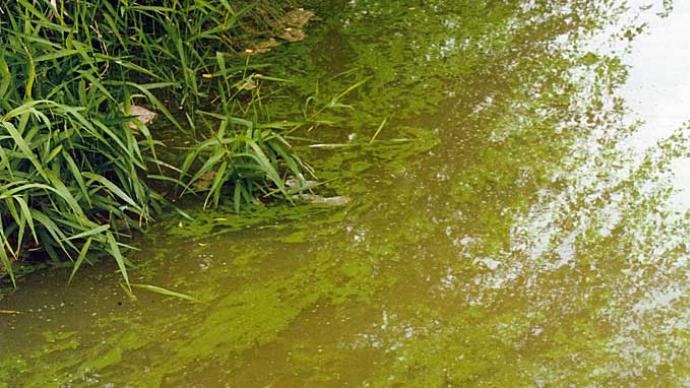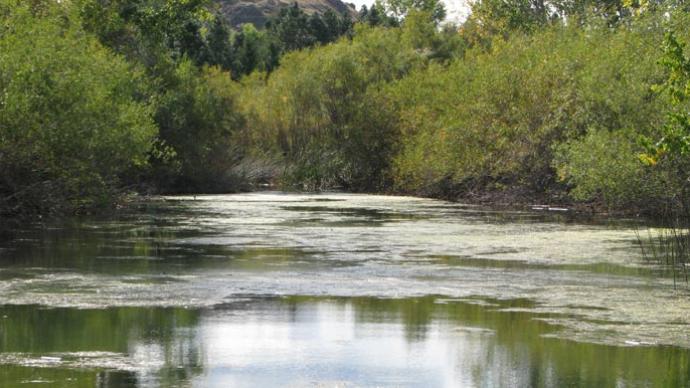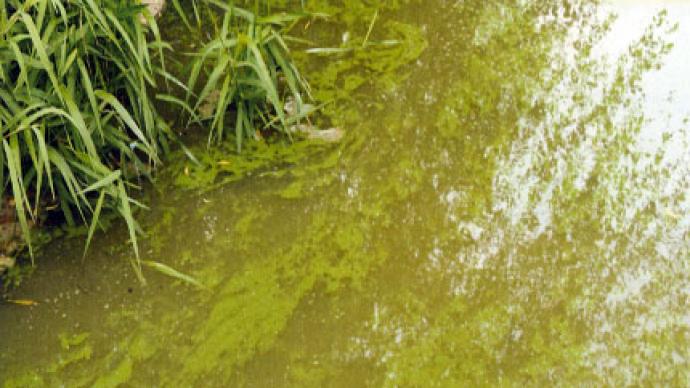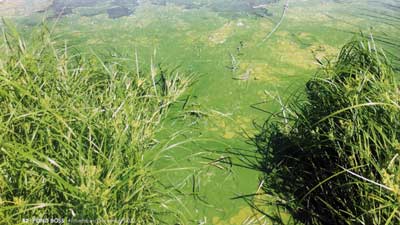
Harmful algal blooms (HABs) have been a hot topic across the United States over the past few years, particularly blooms involving species that can release natural acute or chronic toxins under certain conditions—heavy on the words "certain conditions." These toxins potentially threaten fish, livestock, pets, and humans who contact or ingest water containing them.
While cyanobacteria are present in nearly every water body, HAB cases related to cyanobacteria or "blue-green algae" have increased numbers across several states experiencing moderate to exceptional drought conditions, especially during the summer months. These conditions have dramatically increased fish kills, and livestock deaths reported to the Texas A&M AgriLife Extension Service and the Texas A&M Veterinary Medical Diagnostic Laboratory.
During warmer months nationwide, pond owners should expect some water loss due to increased evaporation rates. For example, in Texas, average gross evaporation rates range between 4 and 5 feet annually. Couple that with the little-to-no rainfall that much of the southwestern states experienced in 2022, and this causes a significant reduction in water volume in waterbodies where fish live, livestock, and wildlife drink, and people want to use and enjoy them.
Dry, hot conditions cause large amounts of evaporative loss to concentrate nutrients that have previously entered and built up in the system. This creates the perfect storm for cyanobacteria blooms, where cells multiply rapidly and outcompete harmless, beneficial algae species by using toxins, known as cyanotoxins, as a defense mechanism.

Cyanobacteria developed cyanotoxins as a defense mechanism against zooplankton predators, and to limit competition for nutrients and sunlight from other planktonic microorganisms such as green and brown algae and diatoms.
As nutrients are used and begin to run out under bloom conditions and competition for sunlight increases, cyanobacteria increase their production of toxins to eliminate competition. Under these conditions, blue-greens become the most dangerous and produce the most toxins.
To complicate our thinking and management strategies, not all cyanobacteria species produce toxins. Some species produce nonlethal toxins, causing minor skin and mucous membrane irritation. Some species produce a single toxin that, if ingested, can be fatal, while others produce multiple toxins that can be fatal if ingested.
It sounds scary, but we all need to educate ourselves and be alert to the circumstances of our ponds.
The type of toxin and the quantity produced and ingested determine whether it will be fatal to a dog compared to a deer, a horse, a cow, or an elk in the wild. Body size, species, and the animal's physiology are significant factors.
Different species of cyanobacteria produce different cyanotoxins, including cytotoxins, endotoxins, hepatotoxins, and neurotoxins.
Endotoxins are typically the least toxic and only become problematic after ingesting large quantities of the live cyanobacteria, and typically result in intestinal discomfort, vomiting, and diarrhea. Cytotoxins are typically low to moderate in toxicity, causing minor to moderate irritation of the skin and mucous membranes. Hepatotoxins are highly toxic, resulting in severe liver damage and potential failure, but typically require repeated ingestion of contaminated water as the toxins build up in the liver over time and result in death in hours to days. Neurotoxins are highly toxic and can result in failure of the neurological system, resulting in heart cessation and breathing failure in minutes to hours.
To further complicate the issue, cyanobacteria species that produce these toxins do not always produce them. There can be many cells per milliliter of water of these toxin-producing bacteria, but as long as nutrients are not limited and environmental conditions remain favorable, they will not produce or release toxins. Cyanobacteria typically produce the toxins under 'bloom' conditions.
The common name "blue-green algae" is a little misleading when characterizing the hundreds of known cyanobacteria species since they are, in fact, photosynthetic bacteria with many different growth forms and colorations. Notably, cyanobacteria blooms are not always "blue-green" but can range from brown and rust-red to turquoise blue to brilliant green. They can appear green, yellow, brown, red, purple, etc., due to protein complexes that produce various pigmentations in their cells.
Cyanobacteria can also have many different growth forms, and identification can be difficult even for the experienced eye. Some microscopic cyanobacteria species are considered to be similar to true planktonic algae species and are mixed evenly throughout the water column, not giving off any visual cues. Other, more visible cyanobacteria species can be found floating in downwind areas along banks in various growth forms, primarily characterized as "spilled paint." Some species are filamentous and form unsightly surface mats or mats growing over the bottom or submerged vegetation.
Other forms include small, irregular, round, or egg-shaped clumps of dark green or dark blueish-green algae that float along at the surface and may form mats along windblown edges of ponds. The genus Microcystis, which produces the potent hepatotoxin microcystin-LR, often starts as a fine film or scum at very low densities during the initial phase of a bloom and forms round or egg-shaped, gelatinous, floating clumps after the population density increases.
The absence of these surface scums does not mean the water is safe, as many toxin-producing cyanobacteria species are filamentous and can be mixed in with typical harmless species of filamentous algae that form dense floating mats during summer months. However, these species are difficult to detect or differentiate visually.
Due to their prolonged exposure time and direct exposure of vital respiratory organs, or gills, to the toxin-contaminated water, aquatic life such as fish, turtles, and frogs are likely to die and be observed before any observed issues with animals that drink from the pond. If uncertain, as a general precaution, humans, livestock, or pets should not be allowed to swim in or drink from any waterbody that is intensely green or blue-green in color due to an obvious high density of algal cells or exhibits any type of brightly colored surface scum.
Usually, this high density of algal cells is due to a bloom of harmless green or brown algae or even non-toxin-producing cyanobacteria, but that cannot be ascertained simply by looking at it. It may be a bloom of toxin-producing cyanobacteria or have toxin-producing cyanobacteria mixed in, so it is best to avoid it.
Common Misidentifications
Sometimes, a cyanobacteria bloom may also be confused with other organisms or aquatic vegetation to the untrained eye. Common misidentification mistakes may seem irrelevant, but each of these groupings has unique survival strategies, which play a huge role in management. With knowledge of a few key characteristics, a cyanobacteria bloom may be ruled out.
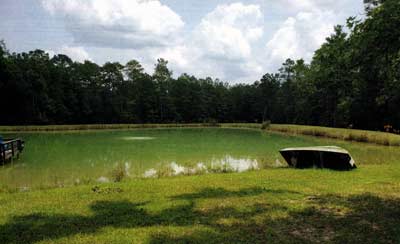
Euglena, single-celled flagellates, can also be found in any water body and even soil. Euglena are unique because they can change color rapidly depending on sunlight, going from green to rusty red within minutes. A good indication that a pond is experiencing a Euglena infestation versus a cyanobacteria bloom is the water changing color within 24 hours, becoming redder with more sunlight.
Golden alga are pigmented to give off a golden appearance and are commonly found in waters with high salinity or rich in minerals during cooler months. While golden alga blooms produce toxins and threaten aquatic organisms, there is no known direct threat to humans, wildlife, livestock, or pets.
From a distance, some of the world's smallest flowering plants, watermeal (Wolffia spp.), are sometimes confused with a cyanobacteria bloom. Like some cyanobacteria species, watermeal is bright green and can be found heavily concentrated along the edges and in downwind areas of a pond due to its free-floating nature. However, upon closer inspection, watermeal will have a seed-like appearance with a gritty texture.
Reporting & Testing
There are no reporting or monitoring programs for cyanobacteria at the state or federal level in private waters. If you believe you are experiencing a cyanobacteria bloom, contact your Extension agency, local Extension agent, or pond management company. Often, pond management companies will have quicker access to established labs capable of conducting highly specialized testing to identify cyanobacteria species and test for toxins. Most universities and Extension agencies do not have labs capable of testing for cyanotoxins and must ship samples off to be tested.
Testing is not always the answer, as testing consists of two parts. The first is visual identification, in which a person trained in algae species identification microscopically examines a water sample, carefully inspecting it to determine if cyanobacteria cells are present, how many cyanobacteria species are present, and at what density each cyanobacterium is present. This only tells half the story.
If toxin-producing cyanobacteria species are present in the sample at high concentrations, the second step is to test to determine if cyanotoxins are present. If so, it's necessary to determine what type of toxins and at what concentration each toxin is present.
Several types of cyanotoxins may be present, and each one must be tested and quantified individually. There is no overall test to measure total toxicity or toxins present. This is the only way to determine the potential toxicity of the water to animals that drink it or swim in it. Therefore, testing can become quite expensive.
A sample tested only provides a single snapshot in time. Just because no toxins were found in a sample tested today does not mean there weren't any toxins present the week before, and it certainly does not mean there won't be any toxins present tomorrow, next week, next month, or next year. To confirm that cyanotoxins are the cause of death for livestock or wildlife, a necropsy is recommended over a water sample.
Management
The best type of management is prevention. Limiting phosphorus runoff from fertilizer, animal waste, septic systems, etc., and maintaining proper buffer strips and livestock grazing around ponds can reduce the chances of experiencing bloom conditions. Too much phosphorous in a water body causes a nitrogen imbalance, which creates a competitive advantage for cyanobacteria because they can fix atmospheric nitrogen to outcompete other beneficial species of algae.
If a bloom is suspected, it should be treated immediately with an algaecide registered for aquatic use in your state. Usually, these are algaecides containing a copper-based product (copper sulfate or chelated copper complexes) or sodium carbonate peroxy hydrate to lyse the algal cells. Cyanobacteria will begin to release toxins as they die, potentially worsening any fish or wildlife kill occurring, so it is crucial to treat the bloom slowly in sections by treating no more than 10 to 15% of the pond area at a time and waiting 10-14 days between each subsequent treatment.
If a fish kill occurs or is worsened by the algaecide treatment, two parts per million of potassium permanganate should be added to the pond to neutralize the cyanotoxins.
The following should also be done when possible:
- Restrict access to livestock, pets, and humans.
- Add supplemental aeration.
- Flush with fresh water.
- Stop feeding and harvesting fish.
Other types of management, including skimming, dilution, pond dyes, etc., are also options, but the level of control will vary due to cyanobacteria species and pond logistics.
The more we learn about blue-green algae, the more important it is to understand the best ways to prevent it in the first place. Learn how your water behaves and do what you can to minimize nutrient input. Or learn how strategies mitigate existing nutrient loads and sequester those nutrients, especially phosphorus, to keep them from becoming available to these unpredictable HABs.
Ms. Brittany Chesser is an Aquatic Vegetation Management Program Specialist, and Dr. Todd Sink is an Associate Professor and Aquaculture Specialist in the Rangeland, Wildlife and Fisheries Management Department and Texas A&M AgriLife Extension Service based at Texas A&M University. Reach them at brittany. chesser@tamu.edu or todd.sink@tamu.edu
Reprinted with permission from Pond Boss Magazine

